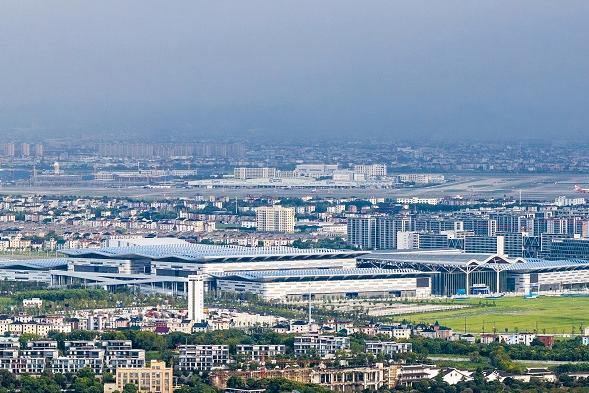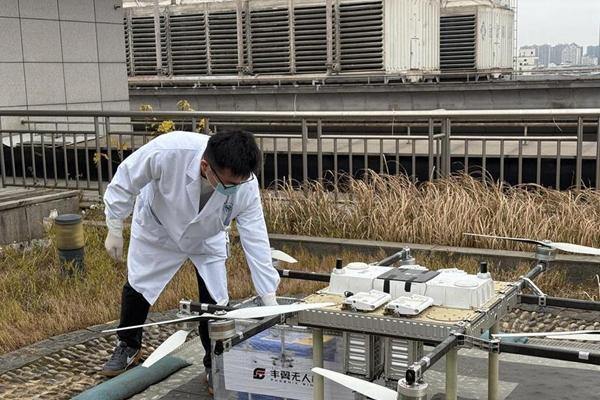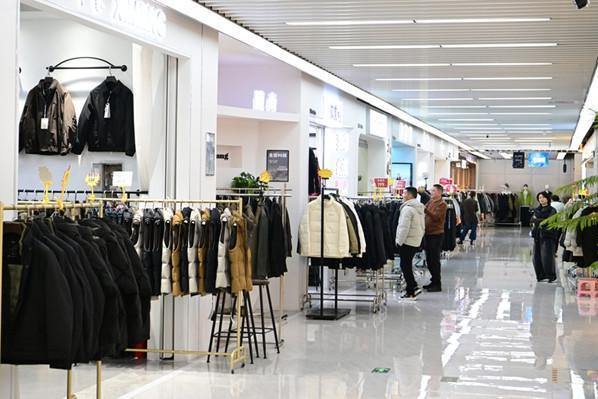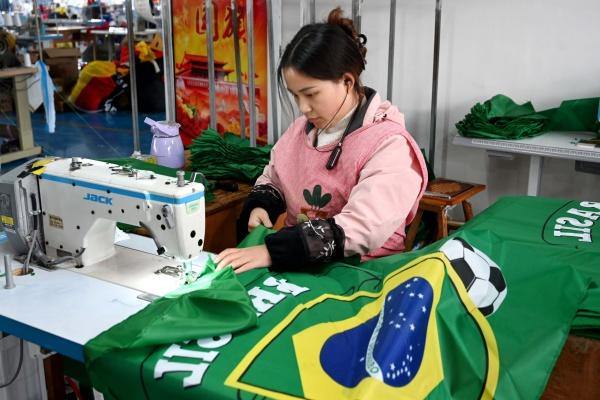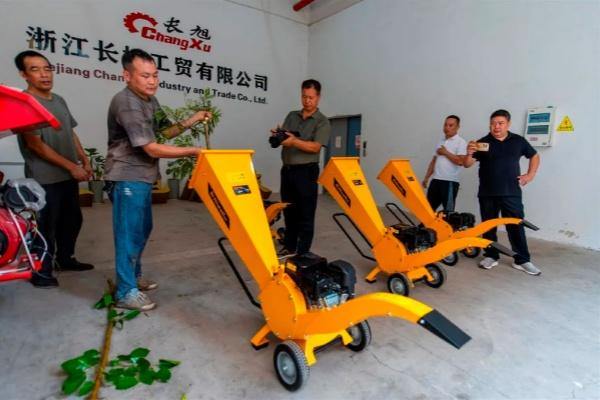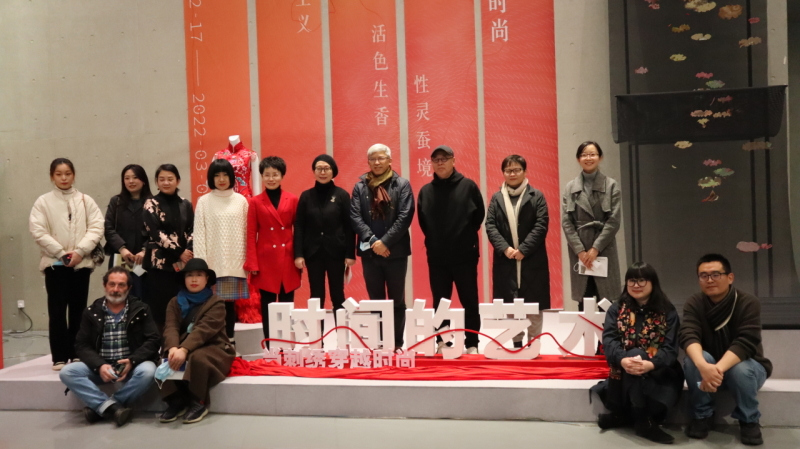
The organizers of the exhibition (Photo/Huang Yan)
The exhibition themed The Art of Time: When Embroidery Goes Through Fashion kicked off at the China National Silk Museum in the afternoon of December 24. The exhibition is sponsored by the Department of Culture and Tourism of Zhejiang Province, Zhejiang Provincial Bureau of Cultural Relics, hosted by China National Silk Museum, China Academy of Art, and it will last until April 10, 2022.
The exhibition was jointly planned by the China National Silk Museum and the team led by Professor Wu Haiyan from the School of Design and Art in the China Academy of Art, inviting more than 70 famous fashion designers, embroiderers, cross-border artists and related institutions to exhibit a total of 114 pieces of embroidery work. The exhibition The Art of Time: When Embroidery Goes Through Fashion aims to present a colorful picture of the close connection between Chinese embroidery art and the aesthetics of Eastern fashion. There are five exhibition sections to illustrate five types of the beauty of embroidery art in contemporary fashion life: the beauty of natural and elegant imagery, the beauty of colorful and vital life, the beauty of unconventional trends, the beauty of inherited yet innovative folklore, and the beauty of diversified future of technology.
Natural spirituality
“In mountains and waters” is becoming more and more a new fashion of Eastern aesthetics. Artworks with the theme of a landscape can make modern people feel the natural spirituality and the traditional aesthetic sentiments, and thereby experience the integration of life and things in a transcendental sense that humans are celestial beings, an extraordinary beauty.

The embroidery work connotes the aesthetics of water and mountain (Photo/Huang Yan)
In the section Natural Spirituality, the artists use their new embroidery languages to express the spiritual landscape they experience and interpret the spirits of Eastern aesthetics by simple yet complex, abstract yet concrete approaches. Just as silkworms eat mulberry and spit out silk to make clothes, the artists also use silk thread to outline mountains and rivers, woods and stones, to write words and ideas, and to connect the past and the present, the spiritual and the daily life via in and color alike that is intent on expressing the longevity and elegance of the Eastern fashion.
Floating fragrance
Embroidery is both art and life, both needlework and poetry, calligraphy and painting. People not only put their visions of the present and the future into the warp and the woof but also their sincere sensations of worldly existence and daily life.
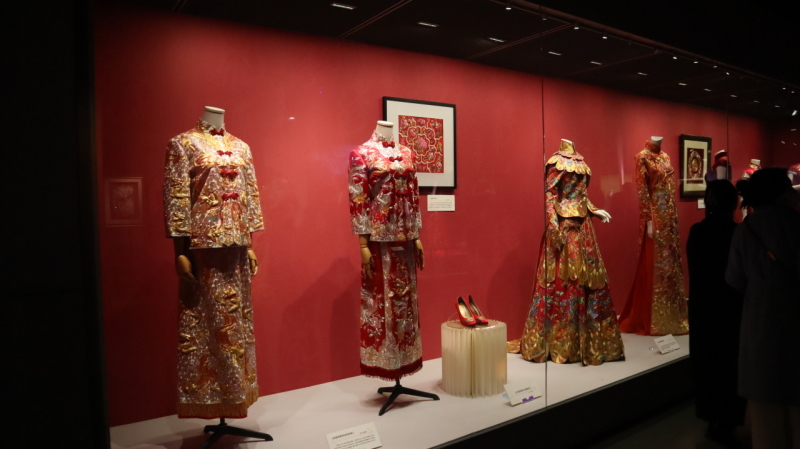
The embroidery work of Chinese traditional wedding dress (Photo/Huang Yan)
The section Floating Fragrance presents the colorful pictures of contemporary life and the fashionable aesthetics of “what the crudest is the noblest”, i.e., using very ritualistically the intricate craftsmanship in the basic red tone to express the satisfaction of material wealth and happiness. Master embroiderers, artists, and fashion designers create rich textures and patterns through a variety of embroidery techniques such as gold-work, barbola, and faggoting, etc., resulting in gorgeous and exquisite works.
Younger trend
In the structure of modern fashion, the avant-garde leads the running of the trend, and the so-called urban youths and street has become an undeniable fashion trend of the moment. The artists are keenly aware of the conflicts and choices of contemporary life and individual worlds, expressing strong self-assertion via retro, natural, emo, anti-fashion irony, and creating new totems, etc.

The embroidery work Listen to Mom’s words drawing the inspiration of the Chinese characters (Photo/Huang Yan)
In the section Younger Trend, we discuss the possibility of rejuvenating embroidery fashion and how to soothe the soul and balance the relationship between the object and the subject through tradition and craftsmanship in an industrialized context. These works infuse embroidery with the passion and charm of the young and avant-garde, making itself youthful and vibrant in fashion.
Local Cadenzas
China’s long history and culture have been immersed in time and condensed into various intangible cultural heritages, which are conveying to future generations what are traditions and what are classics in various art forms such as literature, music, theatre and visual arts. As one of the classics and national treasures, just like the male roles, female roles, painted-face and clowns on the stage of Perking Opera, embroidery is also playing its own role in the contemporary creation of fashion, thus increasingly stepping out of the frozen space and time of the past and transforming into a continuous dimension of art and life.

The traditional Peking Opera elements in the display (Photo/Huang Yan)
In the section Local Cadenzas, artists combine local resources, folk crafts and opera motifs to create contemporary works that expand the realm of embroidery medium while conveying the plurality and diversity of fashion.
Diversified Future
In the 21st century, with the explosion of technology and information, society has undergone tremendous changes, and human beings are facing many challenges in various fields of nature, technology and humanities, and need to face these issues directly with an open and prudent attitude.
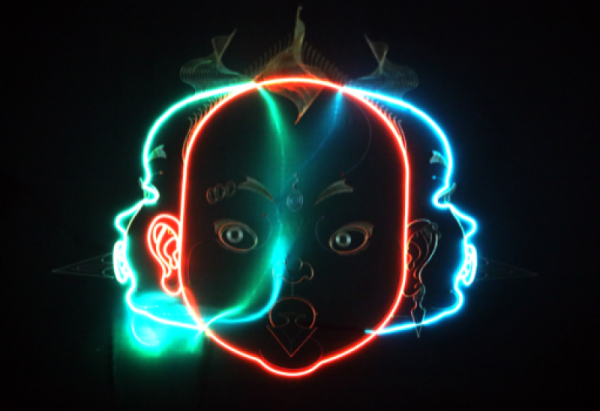
The traditional folklore figure Neza uses the materials of LED neon light (Photo/Huang Yan)
In the section Diversified Future, embroidery masters and contemporary artists collaborate in creating multimedia works such as video and installation, presenting their unique experiences and perceptions of the world and the time. While conveying the artists’ personal concepts, these works also give embroidery art new fashion imagery—futuristic and pioneering.
From 2011 to 2020, China National Silk Museum has held an annual fashion exhibition for 10 consecutive years and has now completed the collection display about 5,000 pieces of clothing works, fashion brands, home textile fabrics, etc. By 2021, the China National Silk Museum to gradually create the “Fashion Plus” themed fashion exhibition, so as to better promote the multi-level, multi-angle interpretation of the cultural connotations of fashion.

The showcase of woman hat in the 19th century (Photo/Huang Yan)
At the same time, another new year’s exhibition Fashion in Hats: Western fashion hat of the 19th and 20th Centuries made its debut. As an accessory of clothing hats not only have the practical functions of keeping out the cold, sun, rain, and protection but also play an important role in decoration. In the 19th and 20th centuries, western fashion hats ushered in their heyday, acting as a symbol of fashion trends and status. The exhibition sorts out the hats from the western fashion collection of the Museum and reproduces the modem style of western fashion hats in the 19th and 20th centuries by exploring the historical background, artistic features, category functions and brand stories of fashion hats.
Author: Huang Yan
Editor: Ye Ke
